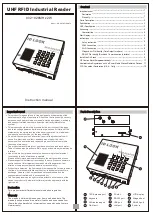
Page
3
of
6
3010002678
Owner’s Manual Slim Rack Bunk Lift System
Preventative Maintenance
Your Power Gear bunk lift system has been designed to require very little maintenance. To
ensure the long life of your bunk lift system, read and follow these few simple procedures:
•
When the bunk is in the down position, visually inspect the gear rack assemblies. Check
for excess build up of dirt or other foreign material; remove any debris items that may be
present.
•
If the system squeaks or makes any noises, blow out any debris from the gear rack arms
and apply a non-silicone based dry lubricant to prevent and/or stop squeaking.
If you have any problems or questions, please see the contact
tab on our website at www.powergearus.com
Fault Diagnostics/Troubleshooting
1217 E. 7
th
St.
Mishawaka, IN 46544
www.powergearus.com
This control has the ability to detect and display several faults. When a fault is detected, the
bunk movement will stop and two (2) different LED’s will flash in a pattern.
•
The
FAULT CODE
LED (
FIGURE 1, page 1
) on the touchpad will flash
RED
a
number of times corresponding to a specific fault code. Refer to the
TROUBLESHOOTING
chart
(Figure 5, page 4)
to best determine what caused the
fault.
•
The
BUNK MOVEMENT
LED (
FIGURE 1, page 1
) on the touchpad will flash
GREEN
a number of times corresponding to which motor had the associated fault.
For example: if you are seeing four (4)
RED
flashes and two (2)
GREEN
flashes, it means that there is a motor fault on motor 2.
There are two (2) types of faults,
MINOR
and
MAJOR
, and fault must be cleared in order for
the bunk to operate.
•
MINOR
faults can be cleared by pushing and releasing the
UP
or
DOWN
buttons on
the bunk lift touchpad (
FIGURE 1, page 1
).
•
After the problem has been repaired,
MAJOR
faults must be cleared by pushing
and releasing the
SET STOPS/CLEAR FAULTS
button located the back of the
bunk lift touchpad (
FIGURE 3, page 2
).
Note: For major faults, the control must be overridden by following the EMERGENCY BUNK
MOVEMENT in the OVERRIDE MODES section on starting on page 4. The control will then
have to be re-programmed by an O.E.M authorized dealer when the problem is repaired.
•
Always make sure that the
bunk lift path is clear of
people and objects before
and during operation of the
bunk lift.
•
Always keep away from
the gear racks when the
bunk lift is being operated.
The gear assembly may
pinch or catch on loose
clothing causing personal
injury.
WARNING
Lowering the bunk:
1. The engine or generator must be running, or plugged into shore power.
2. Transmission must be in PARK or NEUTRAL.(if equipped)
3. Level the unit. (if equipped)
4. Remove the locking pins
.
(if equipped)
(Contact OEM for details)
5. Turn “on” the on/off switch or key. (if equipped) (
Contact OEM for details)
6. Press and hold the
DOWN
button (
FIGURE 1, page 1
). A slight delay is normal
before the bunk begins to move.
7. Release the button when the bunk is fully lowered and stops moving.
8. Turn “off” the on/off switch or key. (if equipped) (
Contact OEM for details)
Raising the bunk:
1. The engine or generator must be running, or plugged into shore power.
2. Transmission must be in PARK or NEUTRAL.(if equipped)
3. Remove locking pins. (if equipped) (
Contact OEM for details)
4. Turn “on” the on/off switch or key. (if equipped) (
Contact OEM for details)
5. Press and hold the
UP
button (
FIGURE 1, page 1
). A slight delay is normal before
the bunk begins to move.
6. Release the button when the bunk is fully raised and stops moving.
7. Turn “off” the on/off switch or key. (if equipped)
8. Install the locking pins. (if equipped) (
Contact OEM for details)
Operation Mode (Continued)
























